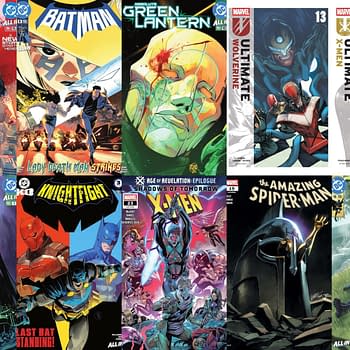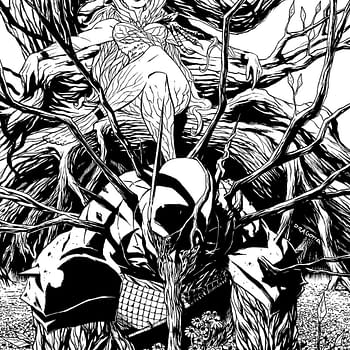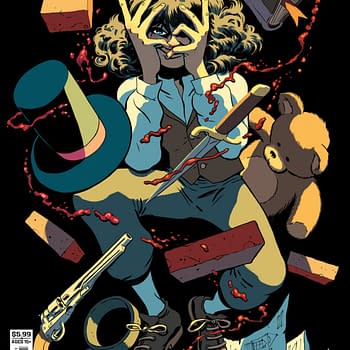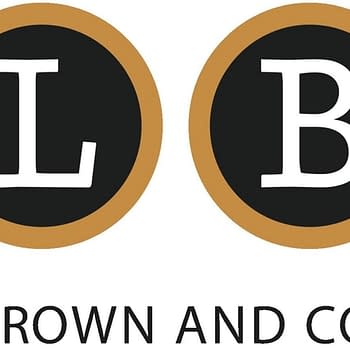Posted in: Comics, Recent Updates | Tagged: Art Spiegelman, Bill Kartalopoulos, City of Glass, Comic Arts Brooklyn, david mazzucchelli, paul auster, Paul Karasik
Twenty Years On, City Of Glass Is Still Avant-garde – Paul Auster, Art Spiegelman, Paul Karasik, and David Mazzucchelli In Conversation at Comic Arts Brooklyn
Paul Karasik (The New Yorker), David Mazzucchelli (Daredevil, Asterios Polyp), and Art Spiegelman (Maus, In the Shadow of No Towers ), sat down for the first time in a public forum to discuss the work they created 20 years ago, the graphic novel adaptation of Auster's City of Glass. With 20 years to think about it, the panelists had some surprising things to say about what has become a touchstone in graphic narrative, a work that pushed the limits of visual language and handled a story that filmmakers have optioned but have never managed to translate to the silver screen because of its intricacy and layered narrative. Bill Kartalopoulos moderated the panel (series editor for Best American Comics, Rebus Books) that also revealed for the first time some of the process notes and sketches that helped these creators tackle adaptation in radically imaginative ways.

When Spiegelman spoke to Auster 25 years ago about creating some graphic novels, and then, finally, about helping with an adaptation of his book, Spiegelman was facing an uphill struggle to bring the "novel" to the graphic medium. At the time, Maus was doing well in shops, but found it in "company" with crowded shelves of "dungeons and dragons manuals", and the book really "needed to be separate from Garfield collections". He set off on a mission to get more novelists interested in the medium.
"It's a rather rarified language", Spiegelman commented, meaning novelists approaching comics were finding the medium mysterious. Screenwriting was more lucrative and easier to understand. "Everyone was interested until they started looking at what was involved", Spiegelman said.

Auster made "one request" to the adapters, saying, " You can take out as much as you want but don't add any words that are not in the book". He wanted nothing included in the graphic novel that didn't come from the original text and was "satisfied with that kind of solution".
Kartalopoulos commented that there was something similar about the context in which Auster's and Spiegelman's work came to be widely known. Auster had been was involved in student protests at Columbia in 1968 and while Spiegelman was also a voice of protest, he was into "communes and LSD rather than front lines and barricades", Spiegelman said. In one of Spiegelman's classic statements about society which makes hearing him speak so punchy and entertaining, he assured the audience, "America has turned psychotic today, but that was another psychotic moment in American history".
Auster said that in 1968, there were "moments of great intensity and that was one of them. I was not an activist in the sense that most of my time was spent reading books and writing, but I had strong political conviction, but there it was. The moment came and I wanted to participate". Spiegelman added that though his "ambient empathies" were the same, he was also "hoping to meet a nice hippie woman" along the way.
Kartalopoulos reminded the audience that the novel City of Glass and the first volume of Maus came out close to eachother in time as "liminal books" of their time.

Spiegleman has also faced misapplication of credentials, and was surprised when he read an article applying "post-modernism" to his work since he had never even heard the appellation before at the time. He was "interested in modernism" and felt that's what he was doing. Both Auster and Spiegelman laughed about the fact that they've also been referred to as "post post-modernists" and have little idea what that entails.
Auster interjected to clarify that between he and Spiegleman, " Both of us like film noir but we don't have very serious discussions. Mostly about smoking and what are we going to have for dinner".
Artist on City of Glass, Mazzucchelli delved into the publication history of the graphic novel by discussing the original cover for the book. It was originally supposed to be part of a series a series of adaptations of existing contemporary noir books, so that "dictated a lot about way first version" looked under the banner "Neon Lit". The book missed its initial release date by a narrow margin, and the distributors said it would be released the next season, but instead the book was "released as a back order with no follow up", making it very difficult to get a hold of.
Spiegleman, who spear-headed the Neon Lit impression said, "I didn't want to do it. I don't believe in adaptations very much. Something else I don't believe in is collaboration, but it's something I'm doing increasingly. The best graphic novels made by single units. The only one I agreed to do it originally with was Paul [Auster]. Even then, he had his doubts, since City of Glass was "one of the least visual books I've ever been able to read". The language of it kept his interest.
Neon Lit folded not long after its inception, leaving City of Glass out of print for several years. It was "highly regarded in comics circles though hard to find", Kartalopoulos said.
Mazzucchelli showed some sketches and drafts on a projected screen, and described sitting at a café table at Angouleme with Art Spiegleman talking about the project, explaining it was going to be a series of adapting crime novels. Mazzucchelli explained that he didn't really read crime novels, but he was interested in City of Glass because it "seemed almost impossible". He came up with some rough pages to show he was "thinking about it" though he wasn't sure of how to approach the project.
Karasik jumped in to explain that for him, the story of how City of Glass came about was like a Paul Auster novel. One of Auster's sons was in one of Karasik's classes while teaching at a prep school and before a parent teacher meeting, Karasik read all 3 volumes of the New York Trilogy. Reading them immediately prompted him to make "some random sketches" and he "thought it could be a cool graphic novel". Nothing came of his idea, until 15 years later when he suddenly heard from Spiegelman, who had been his art instructor in an adult learning class at the School of Visual Arts. Spiegelman had said that he was struggling with the first volume of a project, and when Karasik asked about it, learning it was City of Glass, he responded, "Well, I've already started it" and found his 15 year old notes.
The panelists started looking closely at process drawings via projector and commenting on layout and format for City of Glass. The first challenge they faced in adaptation was the temptation to use heavily gridded pages that could make the reader feel "beaten over head with it page after page". Karasik wasn't sure how to solve this problem, but did instigate a flow of deteriorating panels to show mental states. "As sanity drifts from mind, panels start dripping off the page", he said.
Spiegelman said that "one of the reasons" the final version of the book "works so well" was based on an accident. They had "screwed up doing a 4 row grid rather than 3 row grid" initially, which made the book "unreadable". That meant that Mazzucchelli had to "rethink the 4 panel grid to 3", and that allowed Karasik to become more of an illustrator with more leeway. The panelists examined a slide of yellow legal pages with notes and thumbnails, their "first draft".
Karasik used the slide to illustrate that there are "couplets" on the pages of 2 panels each, then they move on to "one panel per bit of dialogue", which "increases the velocity of Stillman's frantic speech page by page until we're at the bottom of the well with him".
The panelists then examined a second draft drawn on white paper, which led Karasik to explain that, for him, the project was initially "missing" an element, New York City as a character, and that Mazzucchelli brought that in from drawing Daredevil. He could draw "urban landscape", "atmosphere", and "air" in a way that eluded Karasik. Mazzucchelli said that his first impression of the rough draft of City of Glass was that there were "places where it had gotten rhythm just right, but places where it was struggling. After talking about it, and opening it up more, that allowed it to be more readable and more accessible to the public".
For Mazzucchelli, the size of book was an issue due to its "small scale", so they went for something "relatively simple". Things in Karasik's version had already been established, for instance that Quinn was a relatively "blank, egg-like character", and once the style is so cartoony, you can't go too realistic, so it needed to exist "half way between cartoon and naturalism". At the time, Mazzucchelli was publishing the comics anthology Rubber Blanket when doing Daredevil, and experimenting with visual styles, veering more toward "cartoony abstraction" himself. "It was a good project for me at that time because my thinking was already going in that direction", he said.
Kartalopoulos brought up a quote from Spiegleman, that "maybe fiction was invented so your spouse couldn't kill you but fiction always struck me as playing tennis without a net". Spiegelman confirmed that he's always struggled with fiction and "trying to find the net". "If you are trying to say something true in fiction, there is a possible shifting of ground rules" which throws him off. In "trying to find that motor", he was "constantly reading books on how to write fiction" and "whining" about this issue to his fiction-writing friend Auster. In fact, trying to find a solution led him to using a "weird object" called a "Plot Genii" from the 1920's which consisted of a spinning wheel of plot elements randomly selected to dictate a starting point on a story.
When Auster found out Spiegelman had resorted to such measures to try to get himself to write fiction, he said, "Art, just think about it. Weren't you ever a kid? You take these little teddy bears and soldiers. It's a puppet show. Just let it happen". Spiegleman spun the wheel anyway and was told to write a story about a "ventriloquist's daughter".
But one of the salient developments in the history of Auster's New York Trilogy is that Spiegelman has designed the new Penguin edition book covers for Auster. As Auster said wryly and proudly, a "book that no one wanted is now a Penguin Classic with a cover by Art Spiegelman" including covers, flaps, and frontispieces.
Spiegleman confessed that "a month was lost there" trying to make a distressed, pulp looking cover on photo shop for the book. "Pulp modern roots in this post modern novel that looks to Derrida were worth bringing to the fore", he quipped, predicting future critiques.
During the Question and Answer period for the panel, Karasik commented on the format for adapting City of Glass, "One of the problem with adaptation is that they are not respectful of original source", so here they didn't add words, but created a "ratio of how many pages of the original we had to tell the adaptation". Based on that, "each page had to have 1.8 pages of information" so if one "graphs" the "highs and lows" of the original, the reader will find that they are "replicated in ratio to the original one, so you are getting the same story".

Mazzucchelli answered, "If I could distill down what my interest is, it is that modernism is a way of thinking about something that "is what it is" rather than being an illusion of something else. These are sentences, these are words, so play with that. It's the job of any artist to know the form you are working in and exploit the strengths of the form".

Readers probably assumed that it had been a difficult project, but were unaware of the nuances that led to its final production and publication, or how close the book came to being labeled "impossible" for adaptation. 20 years later, the book has become a core text of classes in graphic narrative and adaptation, and the pioneer work of Auster, Spiegelman, Karasik , and Mazzucchelli continues to light the way for finding a new visual language in comics adaptation.
Hannah Means-Shannon is Senior New York Correspondent at Bleeding Cool, writes and blogs about comics for TRIP CITY and Sequart.org, and is currently working on books about Neil Gaiman and Alan Moore for Sequart. She is @hannahmenzies on Twitter and hannahmenziesblog on WordPress. Find her bio here.



















